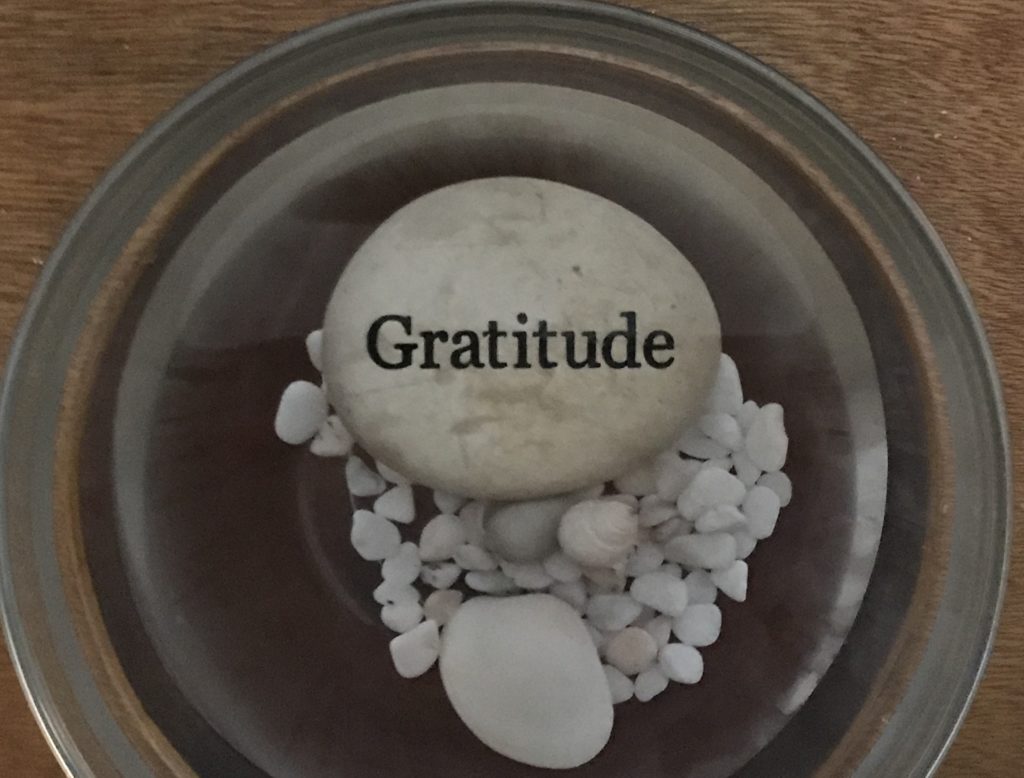We are grateful that we are taking some time off and seeing some fresh views! We’ll be back next week with some new perspectives to share! Enjoy this re-posting of an earlier blog that seemed to resonate with many!
Gratitude makes sense of our past, brings peace for today, and creates a vision for tomorrow – Melody Beattie

Do you think about gratitude during your daily routine? Is it a habit you practice? Deb was recently on vacation and needed some self-care so decided to get a massage. When she was checking into the spa they showed her three smooth stones, each with one of these words on it: Hope, Love and Gratitude.When asked to choose one emotion that she wanted to focus on during the massage, she chose Gratitude. While laying face down during the massage, a smaller stone was placed below her face so she could see and reflect on the word “Gratitude” during the massage, and to help her think about being grateful. (You see that stone in the photo above) This fresh view and experience created a new desire to be more thoughtful and intentional about being grateful for what is and what she has.
What do you think about when you see or hear the word ‘gratitude”? The simple definition is “a feeling of thankful appreciation for favors or benefits received; thankfulness.” But the practice of gratitude means so much more.
According to the American Heart Association several clinical trials show that engaging in a practice of gratitude can lower blood pressure and help the immune system. “Grateful people engage in more exercise, have better dietary behaviors, are less likely to smoke and abuse alcohol, and have higher rates of medication (taking)”. Several studies suggest that gratitude can decrease stress and anxiety by activating the areas in the brain that the release feel-good hormones serotonin and dopamine.
Research discussed in the Jan/Feb, 2019 issue of Diabetes Self-Management also shows that positive psychological states such as gratitude are associated with improved physical health in people with diabetes, improved sleep, and increased self esteem. While the relationship is not fully understood, positive emotions such as expressing gratitude, are linked to healthier lifestyle choices. And healthy lifestyle choices including healthy eating and being active are in turn linked to overall health.
How can you get started with gratitude?
Here are 5 strategies to help develop daily gratitude habits:
- Have gratitude reminders. These are simple cues to remind you to focus on gratitude daily. Maybe it’s an alarm on your phone, a bracelet or wristband, a photo, a magnet even a post it note. And with that reminder, pause, take a breath and focus on being grateful in that moment.
- Keep a gratitude journal. We both have found this to be a good personal practice to express gratitude more readily and find things to be more grateful for. Some log entries in their journal weekly, and others daily. Our personal goal is to identify at least 3 things daily for which we’re grateful. Tami numbers her entries and is working toward 1000 things for which she’s grateful. Some things are big (Entry #622 – Protection through a tornadic storm). Some things are small (Entry #1- Sun and warmth on my shoulders). While the goal is to write in the journal daily, sometimes life happens and weeks may go by without an entry, but we pick right back up with our entries.
- Start a gratitude box. Keeping a box (jar, album, folder, or whatever works for you) filled with notes, pictures, and moments you are grateful for can bring a boost when needed. Tami keeps a folder on her desk and a file on her computer filled with nice notes and photos, as well as an album on her phone of messages and moments she’s grateful for to refer back to when she needs a reminder. Deb has a bulletin board in her office that displays happy memories in photos, ticket stubs, quotes, flyers etc. that she can look at during working at any time.
- Voice or write down one (two, or three) good things that happened in your day. On the homefront, this is a gratitude practice Tami has used with her son over the years. In the days when she would take and pick him up from school, she found that the drive time was a good time to learn about his day. That conversation always began with these words, “Tell me something good that happened today.” He knew he needed to answer that, acknowledging something good, before talking about the challenges of the day.
- Use gratitude apps. There are a number of apps with a range of capabilities including sending reminders, sharing uplifting thoughts, and organizing memories for which you are grateful. Deb has been struggling with back pain from a chronic disc problem and was at a place where no position brought relief, not sitting, standing or lying down. It was getting challenging to think clearly and work. She began using the Calm app, decided to take the Calm masterclass in gratitude, and use their 7 days of gratitude meditation. The process has helped her to find daily items to be grateful for during a time when it was challenging to not be engrossed in the pain.
Here are 3 other things Deb has learned through this experience:
Learning #1 – When you have a chronic condition that is challenging you, think about ways to appreciate and focus on what you do have and what is working for you.
Learning #2 – Try not to compare yourself and what you may be dealing with to others. While the grass might look greener on the other side of the fence, we never truly know what others are going through.
Learning #3 – Trying to simply look at what is right in front of you and be present in the moment.
Maybe you employ one of these strategies. Or several.
Here are 3 tips to help maintain your gratitude practice once you get started:
- Find a daily time to practice gratitude and try to be consistent. Maybe it’s when you get up in the morning. Maybe it’s before you go to bed at night. Maybe it’s when you’re exercising.
- Write what you feel. Don’t censor it.
- Refrain from making the list repetitive. Be specific finding new ways to approach gratitude.
Subscribe to our blog and we’ll email you when a new post is published!
Follow us on Twitter and Instagram @AFreshPOVforYou.





